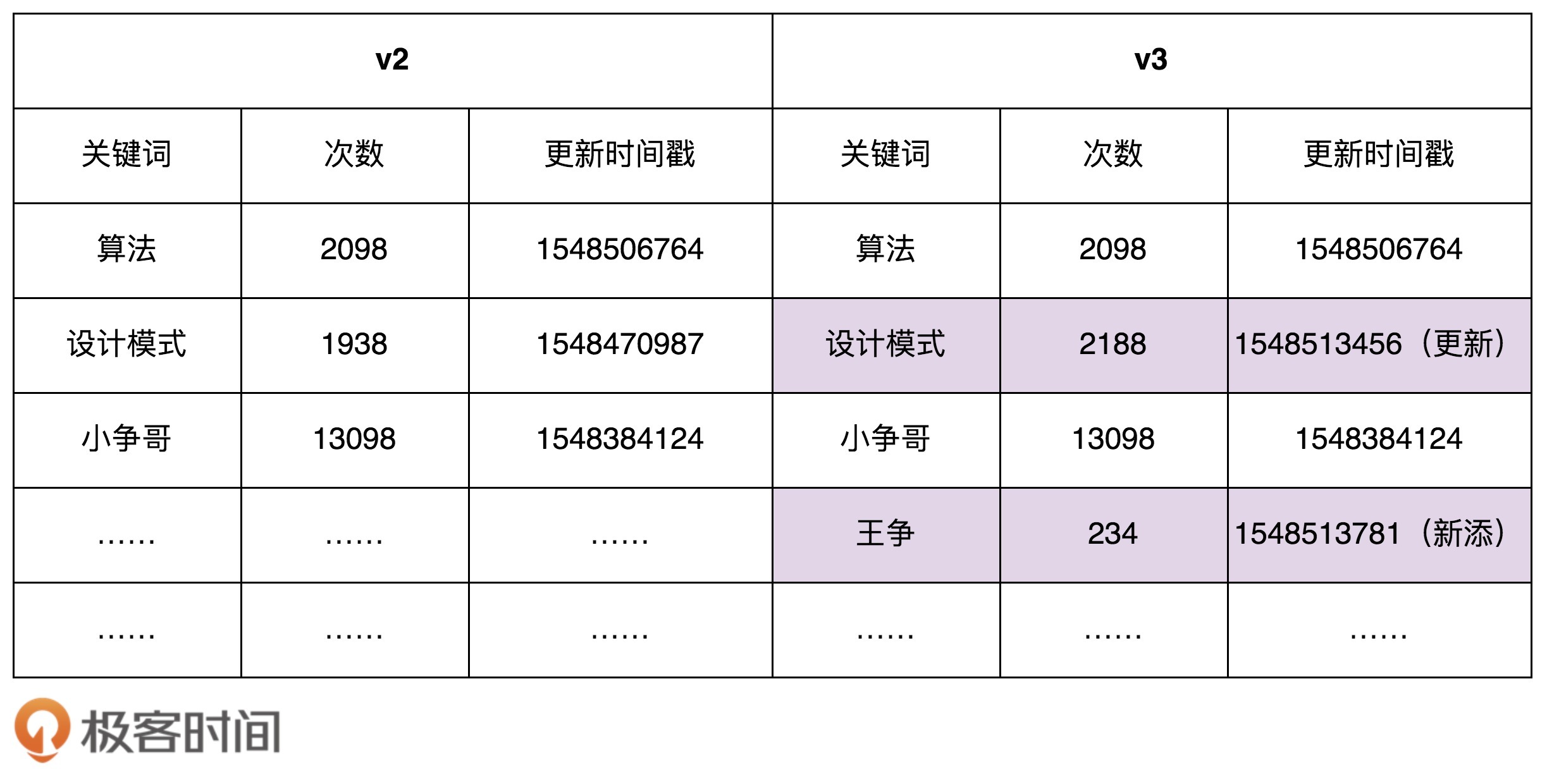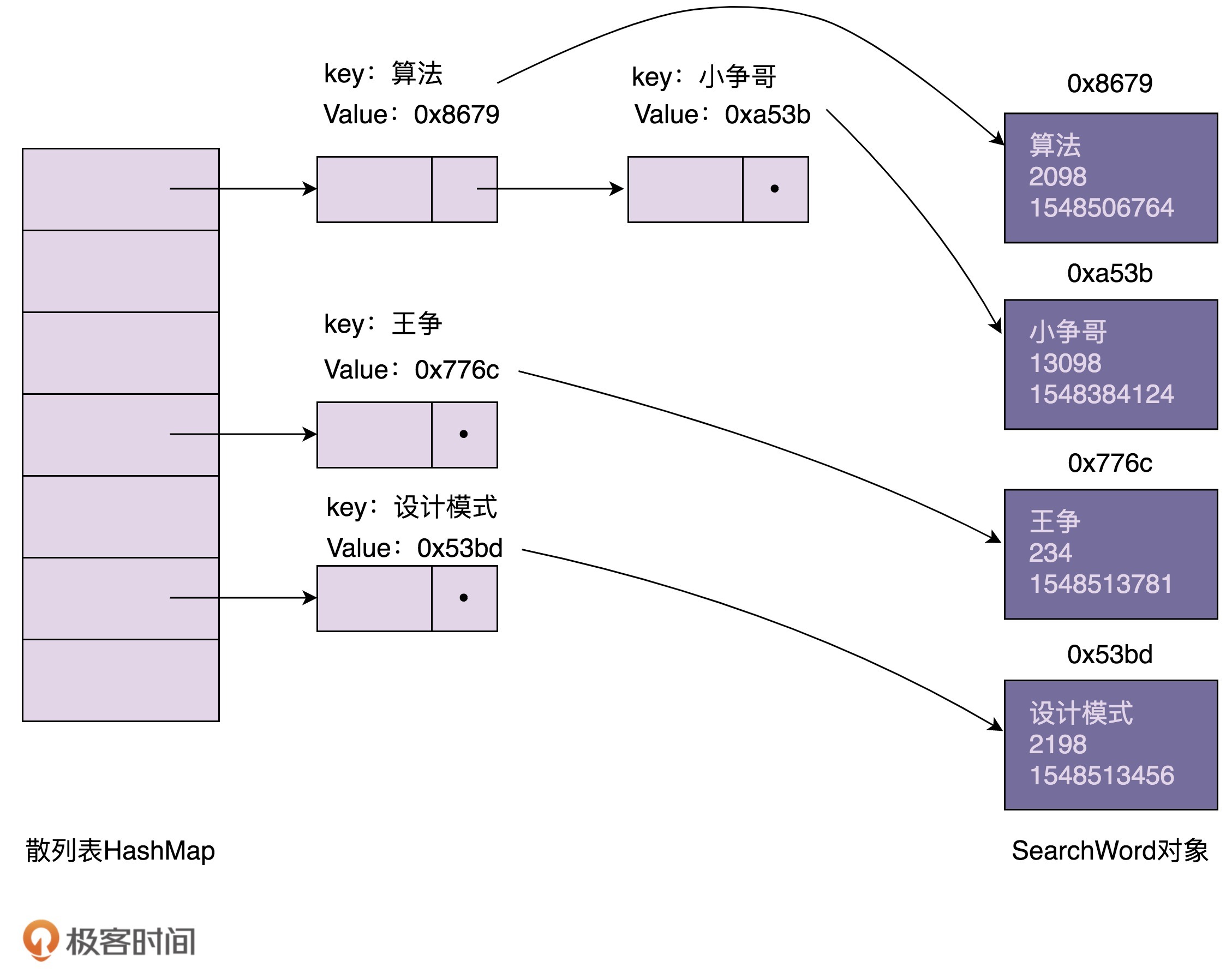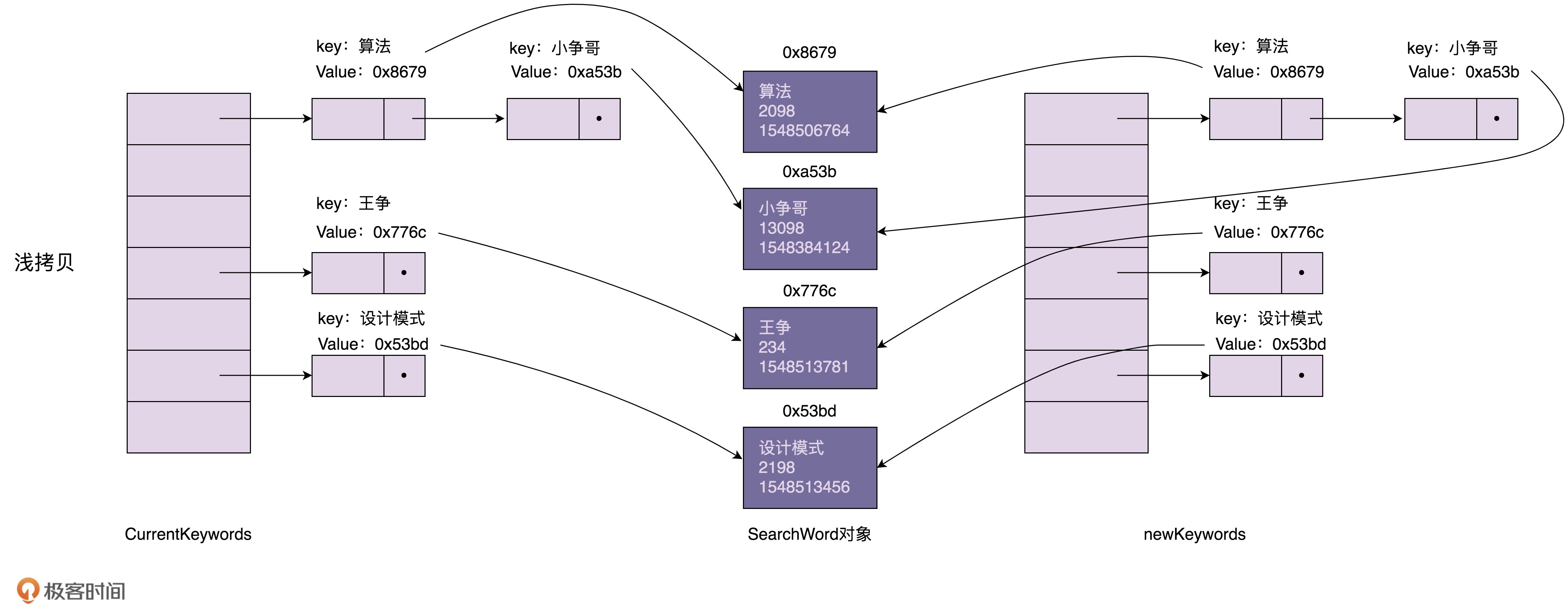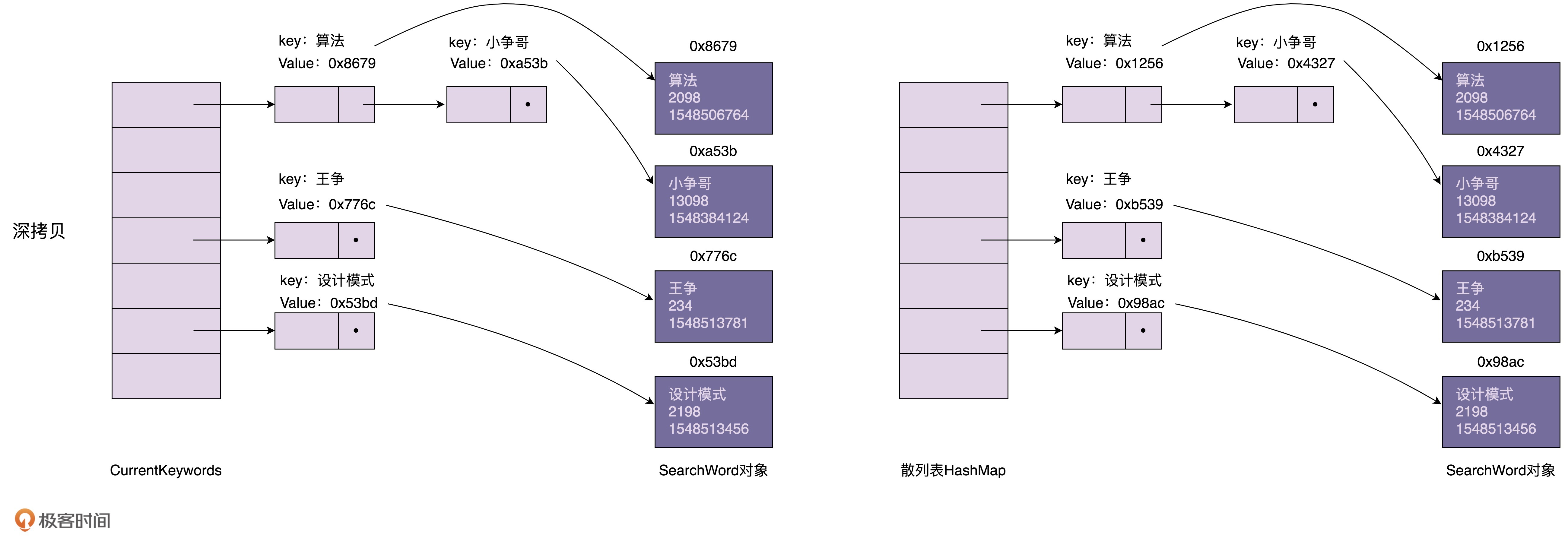47 | 原型模式:如何最快速地clone一个HashMap散列表?
对于创建型模式,前面我们已经讲了单例模式、工厂模式、建造者模式,今天我们来讲最后一个:原型模式。
对于熟悉JavaScript语言的前端程序员来说,原型模式是一种比较常用的开发模式。这是因为,有别于Java、C加加等基于类的面向对象编程语言,JavaScript是一种基于原型的面向对象编程语言。即便JavaScript现在也引入了类的概念,但它也只是基于原型的语法糖而已。不过,如果你熟悉的是Java、C加加等这些编程语言,那在实际的开发中,就很少用到原型模式了。
今天的讲解跟具体某一语言的语法机制无关,而是通过一个clone散列表的例子带你搞清楚:原型模式的应用场景,以及它的两种实现方式:深拷贝和浅拷贝。虽然原型模式的原理和代码实现非常简单,但今天举的例子还是稍微有点复杂的,你要跟上我的思路,多动脑思考一下。
话不多说,让我们正式开始今天的学习吧!
原型模式的原理与应用
如果对象的创建成本比较大,而同一个类的不同对象之间差别不大(大部分字段都相同),在这种情况下,我们可以利用对已有对象(原型)进行复制(或者叫拷贝)的方式来创建新对象,以达到节省创建时间的目的。这种基于原型来创建对象的方式就叫作原型设计模式(Prototype Design Pattern),简称原型模式。
那何为“对象的创建成本比较大”?
实际上,创建对象包含的申请内存、给成员变量赋值这一过程,本身并不会花费太多时间,或者说对于大部分业务系统来说,这点时间完全是可以忽略的。应用一个复杂的模式,只得到一点点的性能提升,这就是所谓的过度设计,得不偿失。
但是,如果对象中的数据需要经过复杂的计算才能得到(比如排序、计算哈希值),或者需要从RPC、网络、数据库、文件系统等非常慢速的IO中读取,这种情况下,我们就可以利用原型模式,从其他已有对象中直接拷贝得到,而不用每次在创建新对象的时候,都重复执行这些耗时的操作。
这么说还是比较理论,接下来,我们通过一个例子来解释一下刚刚这段话。
假设数据库中存储了大约10万条“搜索关键词”信息,每条信息包含关键词、关键词被搜索的次数、信息最近被更新的时间等。系统A在启动的时候会加载这份数据到内存中,用于处理某些其他的业务需求。为了方便快速地查找某个关键词对应的信息,我们给关键词建立一个散列表索引。
如果你熟悉的是Java语言,可以直接使用语言中提供的HashMap容器来实现。其中,HashMap的key为搜索关键词,value为关键词详细信息(比如搜索次数)。我们只需要将数据从数据库中读取出来,放入HashMap就可以了。
不过,我们还有另外一个系统B,专门用来分析搜索日志,定期(比如间隔10分钟)批量地更新数据库中的数据,并且标记为新的数据版本。比如,在下面的示例图中,我们对v2版本的数据进行更新,得到v3版本的数据。这里我们假设只有更新和新添关键词,没有删除关键词的行为。

为了保证系统A中数据的实时性(不一定非常实时,但数据也不能太旧),系统A需要定期根据数据库中的数据,更新内存中的索引和数据。
我们该如何实现这个需求呢?
实际上,也不难。我们只需要在系统A中,记录当前数据的版本Va对应的更新时间Ta,从数据库中捞出更新时间大于Ta的所有搜索关键词,也就是找出Va版本与最新版本数据的“差集”,然后针对差集中的每个关键词进行处理。如果它已经在散列表中存在了,我们就更新相应的搜索次数、更新时间等信息;如果它在散列表中不存在,我们就将它插入到散列表中。
按照这个设计思路,我给出的示例代码如下所示:
public class Demo {private ConcurrentHashMap<String, SearchWord> currentKeywords = new ConcurrentHashMap<>();private long lastUpdateTime = -1;public void refresh() {// 从数据库中取出更新时间>lastUpdateTime的数据,放入到currentKeywords中List<SearchWord> toBeUpdatedSearchWords = getSearchWords(lastUpdateTime);long maxNewUpdatedTime = lastUpdateTime;for (SearchWord searchWord : toBeUpdatedSearchWords) {if (searchWord.getLastUpdateTime() > maxNewUpdatedTime) {maxNewUpdatedTime = searchWord.getLastUpdateTime();}if (currentKeywords.containsKey(searchWord.getKeyword())) {currentKeywords.replace(searchWord.getKeyword(), searchWord);} else {currentKeywords.put(searchWord.getKeyword(), searchWord);}}lastUpdateTime = maxNewUpdatedTime;}private List<SearchWord> getSearchWords(long lastUpdateTime) {// TODO: 从数据库中取出更新时间>lastUpdateTime的数据return null;}}
不过,现在,我们有一个特殊的要求:任何时刻,系统A中的所有数据都必须是同一个版本的,要么都是版本a,要么都是版本b,不能有的是版本a,有的是版本b。那刚刚的更新方式就不能满足这个要求了。除此之外,我们还要求:在更新内存数据的时候,系统A不能处于不可用状态,也就是不能停机更新数据。
那我们该如何实现现在这个需求呢?
实际上,也不难。我们把正在使用的数据的版本定义为“服务版本”,当我们要更新内存中的数据的时候,我们并不是直接在服务版本(假设是版本a数据)上更新,而是重新创建另一个版本数据(假设是版本b数据),等新的版本数据建好之后,再一次性地将服务版本从版本a切换到版本b。这样既保证了数据一直可用,又避免了中间状态的存在。
按照这个设计思路,我给出的示例代码如下所示:
public class Demo {private HashMap<String, SearchWord> currentKeywords=new HashMap<>();public void refresh() {HashMap<String, SearchWord> newKeywords = new LinkedHashMap<>();// 从数据库中取出所有的数据,放入到newKeywords中List<SearchWord> toBeUpdatedSearchWords = getSearchWords();for (SearchWord searchWord : toBeUpdatedSearchWords) {newKeywords.put(searchWord.getKeyword(), searchWord);}currentKeywords = newKeywords;}private List<SearchWord> getSearchWords() {// TODO: 从数据库中取出所有的数据return null;}}
不过,在上面的代码实现中,newKeywords构建的成本比较高。我们需要将这10万条数据从数据库中读出,然后计算哈希值,构建newKeywords。这个过程显然是比较耗时。为了提高效率,原型模式就派上用场了。
我们拷贝currentKeywords数据到newKeywords中,然后从数据库中只捞出新增或者有更新的关键词,更新到newKeywords中。而相对于10万条数据来说,每次新增或者更新的关键词个数是比较少的,所以,这种策略大大提高了数据更新的效率。
按照这个设计思路,我给出的示例代码如下所示:
public class Demo {private HashMap<String, SearchWord> currentKeywords=new HashMap<>();private long lastUpdateTime = -1;public void refresh() {// 原型模式就这么简单,拷贝已有对象的数据,更新少量差值HashMap<String, SearchWord> newKeywords = (HashMap<String, SearchWord>) currentKeywords.clone();// 从数据库中取出更新时间>lastUpdateTime的数据,放入到newKeywords中List<SearchWord> toBeUpdatedSearchWords = getSearchWords(lastUpdateTime);long maxNewUpdatedTime = lastUpdateTime;for (SearchWord searchWord : toBeUpdatedSearchWords) {if (searchWord.getLastUpdateTime() > maxNewUpdatedTime) {maxNewUpdatedTime = searchWord.getLastUpdateTime();}if (newKeywords.containsKey(searchWord.getKeyword())) {SearchWord oldSearchWord = newKeywords.get(searchWord.getKeyword());oldSearchWord.setCount(searchWord.getCount());oldSearchWord.setLastUpdateTime(searchWord.getLastUpdateTime());} else {newKeywords.put(searchWord.getKeyword(), searchWord);}}lastUpdateTime = maxNewUpdatedTime;currentKeywords = newKeywords;}private List<SearchWord> getSearchWords(long lastUpdateTime) {// TODO: 从数据库中取出更新时间>lastUpdateTime的数据return null;}}
这里我们利用了Java中的clone()语法来复制一个对象。如果你熟悉的语言没有这个语法,那把数据从currentKeywords中一个个取出来,然后再重新计算哈希值,放入到newKeywords中也是可以接受的。毕竟,最耗时的还是从数据库中取数据的操作。相对于数据库的IO操作来说,内存操作和CPU计算的耗时都是可以忽略的。
不过,不知道你有没有发现,实际上,刚刚的代码实现是有问题的。要弄明白到底有什么问题,我们需要先了解另外两个概念:深拷贝(Deep Copy)和浅拷贝(Shallow Copy)。
原型模式的实现方式:深拷贝和浅拷贝
我们来看,在内存中,用散列表组织的搜索关键词信息是如何存储的。我画了一张示意图,大致结构如下所示。从图中我们可以发现,散列表索引中,每个结点存储的key是搜索关键词,value是SearchWord对象的内存地址。SearchWord对象本身存储在散列表之外的内存空间中。

浅拷贝和深拷贝的区别在于,浅拷贝只会复制图中的索引(散列表),不会复制数据(SearchWord对象)本身。相反,深拷贝不仅仅会复制索引,还会复制数据本身。浅拷贝得到的对象(newKeywords)跟原始对象(currentKeywords)共享数据(SearchWord对象),而深拷贝得到的是一份完完全全独立的对象。具体的对比如下图所示:


在Java语言中,Object类的clone()方法执行的就是我们刚刚说的浅拷贝。它只会拷贝对象中的基本数据类型的数据(比如,int、long),以及引用对象(SearchWord)的内存地址,不会递归地拷贝引用对象本身。
在上面的代码中,我们通过调用HashMap上的clone()浅拷贝方法来实现原型模式。当我们通过newKeywords更新SearchWord对象的时候(比如,更新“设计模式”这个搜索关键词的访问次数),newKeywords和currentKeywords因为指向相同的一组SearchWord对象,就会导致currentKeywords中指向的SearchWord,有的是老版本的,有的是新版本的,就没法满足我们之前的需求:currentKeywords中的数据在任何时刻都是同一个版本的,不存在介于老版本与新版本之间的中间状态。
现在,我们又该如何来解决这个问题呢?
我们可以将浅拷贝替换为深拷贝。newKeywords不仅仅复制currentKeywords的索引,还把SearchWord对象也复制一份出来,这样newKeywords和currentKeywords就指向不同的SearchWord对象,也就不存在更新newKeywords的数据会导致currentKeywords的数据也被更新的问题了。
那如何实现深拷贝呢?总结一下的话,有下面两种方法。
第一种方法:递归拷贝对象、对象的引用对象以及引用对象的引用对象……直到要拷贝的对象只包含基本数据类型数据,没有引用对象为止。根据这个思路对之前的代码进行重构。重构之后的代码如下所示:
public class Demo {private HashMap<String, SearchWord> currentKeywords=new HashMap<>();private long lastUpdateTime = -1;public void refresh() {// Deep copyHashMap<String, SearchWord> newKeywords = new HashMap<>();for (HashMap.Entry<String, SearchWord> e : currentKeywords.entrySet()) {SearchWord searchWord = e.getValue();SearchWord newSearchWord = new SearchWord(searchWord.getKeyword(), searchWord.getCount(), searchWord.getLastUpdateTime());newKeywords.put(e.getKey(), newSearchWord);}// 从数据库中取出更新时间>lastUpdateTime的数据,放入到newKeywords中List<SearchWord> toBeUpdatedSearchWords = getSearchWords(lastUpdateTime);long maxNewUpdatedTime = lastUpdateTime;for (SearchWord searchWord : toBeUpdatedSearchWords) {if (searchWord.getLastUpdateTime() > maxNewUpdatedTime) {maxNewUpdatedTime = searchWord.getLastUpdateTime();}if (newKeywords.containsKey(searchWord.getKeyword())) {SearchWord oldSearchWord = newKeywords.get(searchWord.getKeyword());oldSearchWord.setCount(searchWord.getCount());oldSearchWord.setLastUpdateTime(searchWord.getLastUpdateTime());} else {newKeywords.put(searchWord.getKeyword(), searchWord);}}lastUpdateTime = maxNewUpdatedTime;currentKeywords = newKeywords;}private List<SearchWord> getSearchWords(long lastUpdateTime) {// TODO: 从数据库中取出更新时间>lastUpdateTime的数据return null;}}
第二种方法:先将对象序列化,然后再反序列化成新的对象。具体的示例代码如下所示:
public Object deepCopy(Object object) {ByteArrayOutputStream bo = new ByteArrayOutputStream();ObjectOutputStream oo = new ObjectOutputStream(bo);oo.writeObject(object);ByteArrayInputStream bi = new ByteArrayInputStream(bo.toByteArray());ObjectInputStream oi = new ObjectInputStream(bi);return oi.readObject();}
刚刚的两种实现方法,不管采用哪种,深拷贝都要比浅拷贝耗时、耗内存空间。针对我们这个应用场景,有没有更快、更省内存的实现方式呢?
我们可以先采用浅拷贝的方式创建newKeywords。对于需要更新的SearchWord对象,我们再使用深度拷贝的方式创建一份新的对象,替换newKeywords中的老对象。毕竟需要更新的数据是很少的。这种方式即利用了浅拷贝节省时间、空间的优点,又能保证currentKeywords中的中数据都是老版本的数据。具体的代码实现如下所示。这也是标题中讲到的,在我们这个应用场景下,最快速clone散列表的方式。
public class Demo {private HashMap<String, SearchWord> currentKeywords=new HashMap<>();private long lastUpdateTime = -1;public void refresh() {// Shallow copyHashMap<String, SearchWord> newKeywords = (HashMap<String, SearchWord>) currentKeywords.clone();// 从数据库中取出更新时间>lastUpdateTime的数据,放入到newKeywords中List<SearchWord> toBeUpdatedSearchWords = getSearchWords(lastUpdateTime);long maxNewUpdatedTime = lastUpdateTime;for (SearchWord searchWord : toBeUpdatedSearchWords) {if (searchWord.getLastUpdateTime() > maxNewUpdatedTime) {maxNewUpdatedTime = searchWord.getLastUpdateTime();}if (newKeywords.containsKey(searchWord.getKeyword())) {newKeywords.remove(searchWord.getKeyword());}newKeywords.put(searchWord.getKeyword(), searchWord);}lastUpdateTime = maxNewUpdatedTime;currentKeywords = newKeywords;}private List<SearchWord> getSearchWords(long lastUpdateTime) {// TODO: 从数据库中取出更新时间>lastUpdateTime的数据return null;}}
重点回顾
好了,今天的内容到此就讲完了。我们一块来总结回顾一下,你需要重点掌握的内容。
1.什么是原型模式?
如果对象的创建成本比较大,而同一个类的不同对象之间差别不大(大部分字段都相同),在这种情况下,我们可以利用对已有对象(原型)进行复制(或者叫拷贝)的方式,来创建新对象,以达到节省创建时间的目的。这种基于原型来创建对象的方式就叫作原型设计模式,简称原型模式。
2.原型模式的两种实现方法
原型模式有两种实现方法,深拷贝和浅拷贝。浅拷贝只会复制对象中基本数据类型数据和引用对象的内存地址,不会递归地复制引用对象,以及引用对象的引用对象……而深拷贝得到的是一份完完全全独立的对象。所以,深拷贝比起浅拷贝来说,更加耗时,更加耗内存空间。
如果要拷贝的对象是不可变对象,浅拷贝共享不可变对象是没问题的,但对于可变对象来说,浅拷贝得到的对象和原始对象会共享部分数据,就有可能出现数据被修改的风险,也就变得复杂多了。除非像我们今天实战中举的那个例子,需要从数据库中加载10万条数据并构建散列表索引,操作非常耗时,这种情况下比较推荐使用浅拷贝,否则,没有充分的理由,不要为了一点点的性能提升而使用浅拷贝。